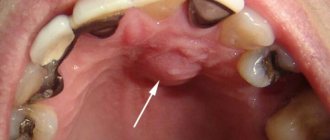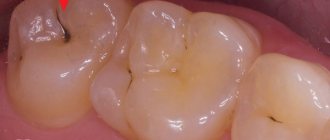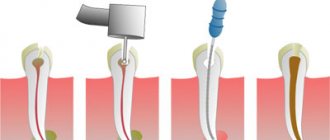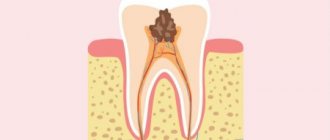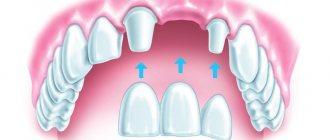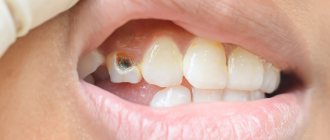If the resulting hole in the tooth is not filled in time, it may collapse and will have to be removed over time. You need to figure out why holes appear in teeth and how to deal with them.
The most basic reason for the appearance of a hole is tooth disease with caries, which first appears as a small dark spot on the tooth enamel. If caries is not treated at the initial stage of its appearance, it can gradually grow, penetrate into the tooth pulp and form a carious cavity. This cavity must be filled so as not to lose the entire tooth. A filling is placed if the tooth is affected by simple caries or complicated caries, or if pulpitis or pericementitis occurs.
How does a hole form in a tooth?
Let us make a reservation that a hole in a tooth is not a diagnosis, but a consequence of a dental disease. The phenomenon visually indicates that there is a problem.
Ideal teeth are straight and smooth. Uncleaned food debris leads to the formation of a special film on the teeth. Dentists call this film plaque. It contains a large number of bacteria. Over time, plaque hardens and becomes strongly attached to the teeth. Pathogenic organisms that are inside produce a specific acid that quickly destroys tooth enamel. It turns out that bacteria and microorganisms gradually begin to destroy teeth. As a result, a person gets a disease such as caries.
Stages of tooth destruction
Initially, small holes are obtained. Later they expand, turning into a hole. The described process can be divided into the following stages:
- First stage: initial. First, a whitish spot appears on the surface, which is the start of the destructive process. Over time, this spot turns from white to brown. At this stage, there are no other (let alone unpleasant) symptoms. Therefore, we people sometimes do not even know about the onset of the disease. At this time, only a dentist can detect it.
- Second stage: development of superficial caries. If the stain is not removed in time, painful microorganisms will affect the very top layer of tooth enamel. A more serious inflammatory process will begin, which is characterized by destruction. Here patients can talk about their complaints. Usually at this time the teeth are very sensitive. They react to temperature changes and acidic foods.
- Third stage: middle. Not only enamel, but also dentin suffers from destruction. Visually you can see a small hole. This is where food regularly falls and is left to rot. In addition to the sensations of the second stage, a reaction to chemical components is added. In addition, a person usually feels pain from inhaling air with an open mouth. If the tooth is not treated, the painful sensations will begin to torment constantly. Even painkillers cannot relieve the symptoms.
- Stage four: deep caries. The hole turns into a cavity and becomes quite large in size. The enamel and dentin itself are made very soft. If you touch the open bottom, you may feel pain. Inflammation of the nerve and vascular tissue begins. As a result, caries turns into pulpitis.
Symptoms
At the initial stage of caries development, the color of the enamel on the chewing or front tooth changes. The surface of the affected unit becomes rough, heterogeneous, and covered with chalky spots. There is no pain, only a cosmetic defect of the tooth is visually noticeable. To cope with this problem, you do not need to drill a tooth; it is enough to use only applications with medicinal compounds or use an innovative toothpaste that closes holes.
As a rule, patients are shown formulations with fluorides, calcium compounds and other substances to remineralize enamel. Superficial caries is a clearly defined area on the enamel of a round, oval shape, and does not differ in color from healthy tissues. In most cases, there is no pain; some patients note increased tooth sensitivity to hot, cold, and sour foods.
Important! The manifestations of superficial caries can be removed by preparation followed by filling.
With medium-depth caries, all layers of enamel are destroyed, which are localized down to the enamel-dentin border, the surface layer of dentin. The tooth hole deepens, is clearly visible to the naked eye, and food particles begin to get stuck in it. This form of the pathological process is eliminated by filling.
Deep caries is accompanied by the formation of large band defects affecting both enamel and dentin. There is pain in the affected tooth, the patient faces difficulties and discomfort during chewing food and hygiene procedures. The tooth reacts sensitively to the action of any external irritants - as soon as contact with them ceases, the unpleasant sensations immediately disappear.
The initial stage of caries “makes itself known” with chalky spots on the enamel
What does a dentist do to remove deep caries:
- places an application with medicinal paste into the hole to restore the dentin structure and relieve irritation from the pulp;
- installs an insulating gasket;
- seals the affected unit.
Reasons for the appearance of holes
A hole in a tooth is a consequence of the carious process. It is formed under the influence of several factors:
Features of people's lifestyle
- improper diets, as a result of which the body weakens and loses essential vitamins.
- poor hygiene or its complete absence.
- insufficient content of such an element as fluorine in the enamel.
External factors
- Having an incorrect bite.
- Bad heredity.
- Floor. It is women who suffer more from caries than men. The above is related to hormonal changes in the female body. And also, it is the weaker sex who eat the most sweets and starchy foods.
- Poor quality of drinking water.
- Particular susceptibility to diseases.
Physiological factor
- Distance between teeth.
- Features of the structure of the jaw.
- Poor quality enamel.
Geographical factor
Surprisingly, the occurrence of caries is influenced by the geographic location in which a person lives. It has been proven that climate, minerals, soil, and topography have a significant impact on human health in general, including teeth. Thus, almost all US residents (with the exception of only 1%) have serious dental problems. In Russia, only 40% of the population has healthy teeth, the remaining 60% suffer from dental problems. And in Norway, only 2% of the population complain of bad teeth.
Nutrition feature
Eating preservatives, carbohydrates, unnatural additives, and large amounts of sweets increases the likelihood of cavity formation many times over.
When there is black caries, but it is still not treated
Many people have encountered a situation where a doctor, during an examination, confirmed the presence of the initial stage of caries, but refused to treat it according to the standard regimen. Why is this happening? The thing is that during drilling of dentin, much more hard tissue is damaged than it seems at first glance. But it is impossible to install a seal without drilling.
Trying to avoid unnecessary destruction of the crown, the doctor does not want to drill into black caries at the spot stage. Very often its dimensions do not change at all for a long time. The spot itself does not cause a person any discomfort. If you brush your teeth thoroughly after each meal, use high-quality toothpaste and remineralizing dental gel, you can maintain caries at its original size for several years, that is, avoid its increase.
Therefore, if the dentist says that there is no need to touch the tooth yet, you should listen to his words. This is a way to preserve hard tissues without changing their volume for the coming years.
Hole in a tooth in children
It cannot be assumed that baby teeth are not susceptible to caries. This is wrong. Pathogenic and dangerous microorganisms very often affect baby teeth. During the period of replacement of temporary teeth with permanent ones, microbes that have settled on milk teeth calmly transfer to new ones that have just emerged. As you know, the entire process of changing teeth is quite long. Therefore, already in childhood, caries can be detected in a child’s mouth.
It is necessary to explain to the baby that he must take care of his oral cavity in the same way as his parents. Leftover food gets stuck between his teeth and causes the appearance of microorganisms. This should be avoided. Therefore, it is imperative to teach your child not only to use a brush, but also dental floss.
Treatment of holes
Depending on the stage of the disease and the reason for the formation of the hole, a person may simply not be bothered by this cavity or may make itself felt by severe pain with fever. The hole must be healed with the help of a dentist. But if you still can’t get to the dentist’s office, you can relieve the pain at home.
Emergency help at home
If pain occurs, you should immediately brush your teeth. This will remove food debris from the mouth. Next, you should take any analgesic drug. The medicine will also help in case of fever.
If swelling is suddenly observed, it can be reduced by rinsing with soda. Or apply a piece of ice to the sore spot for 15-20 minutes.
Very often people resort to our grandmothers' recipes. The older generation claims that the following will help with initial pain in the tooth:
- A piece of lard, garlic, beets and bee propolis attached to the tooth.
- Normal tears, so you need to cry. Tears will relieve pressure in the jaw and thereby reduce the pain slightly.
- Massage the ear from the side of the diseased tooth.
- Gargling with herbal decoctions.
- Rubbing the sore spot with plantain juice.
Independent measures will only alleviate the condition, but will not cure the tooth. If a tooth stops seriously bothering you, this does not mean that the disease has gone away. The disease simply began to occur hidden. It went to the very depths and became chronic. In any case, you will have to go to the dentist.
Doctor's appointments
A hole in the teeth is treated according to the same scheme:
- First stage: thorough treatment of the oral cavity. Here the doctor removes plaque and tartar from the diseased tooth or from the entire oral cavity.
- Second stage: prick or injection of an analgesic. This kind of pain relief is necessary. Under its influence, the patient’s panic fear of treatment goes away, he does not feel pain and thereby allows the doctor to calmly do his job.
- Stage three: removal of infected tissue. Removal is carried out throughout the entire tooth cavity using special dental devices. Next, the doctor coats the walls of the exposed tooth with a bur or antiseptic. As a result of this action, the growth of bacteria and further relapse of the disease stops.
- Stage four: drilling out the cavity to install the filling. This is necessary so that the new installed material fits tightly into the tooth.
- Fifth stage: application of filling material or protective seal. They try to match the material as closely as possible to the color of the patient’s natural teeth. If suddenly the patient’s tooth has been affected by deep caries, then a therapeutic pad is placed at the bottom of the cavity. It will relieve inflammation from the nerve. Read about how to kill a nerve in a tooth here.
- Stage six: adjusting the filling to the shape of the tooth. This action helps the patient not to experience discomfort when chewing in the future.
Home methods
It is possible to cope with caries using folk remedies only when the pathological process is at the stage of a chalky spot. So, special medicinal pastes with fluoride and calcium (they should be selected by a dentist) help to temporarily seal and stop the spread of the anomaly. In addition, it is necessary to normalize the regime, balance the diet - introduce into the daily menu as many foods as possible with a high content of calcium, potassium, fluorine and other useful substances.
Japanese scientists have developed a toothpaste that “seals” holes in enamel
Important! Daily thorough brushing of teeth, gums, and tongue is an important measure for the prevention of caries.
How to quickly relieve pain in a carious tooth at home:
- close the hole with a piece of lard, beets, propolis;
- massage the ear on the sore side;
- rinse your mouth with a decoction of chamomile, calendula, and yarrow.
A filling is the main protection for a hole in a tooth.
Filling material may vary. Let's look at the main ones.
Metal fillings
- From amalgam. It is a special metal combined with zinc, silver, tin and mercury. Currently, copper and silver amalgams are used. Such fillings are quite strong, plastic, they are notable for their low price and good fit to the edges of the cavity. The service life of amalgam fillings is 15 years. The material is able to accurately replicate the shade of the tooth. But a tooth with such a filling stands out from the entire dentition. Such fillings take too long to harden and are difficult to fit into the cavity. In addition, mercury vapor released during work is harmful to the health of the dentist.
- Made of gold alloy. They have enviable strength and a very long service life. But they are practically not used because of their visual visibility. In addition, a gold filling is an expensive pleasure.
Plastic fillings
They are used to temporarily protect the hole. They have good resistance to chemical components, harden quickly and do not irritate the patient’s oral cavity. However, such fillings quickly shrink and change their original shade over time. Plastic fillings can be made:
- Made from acrylic oxide. The material is resistant to any external influence, retains its original shade for a long time, fits tightly to the tooth and gives only slight shrinkage. The disadvantages of such fillings include their toxicity and the ability to start an inflammatory process under the installed filling.
- Made from carbondent. Compared to the filling described above, it has high density and low toxicity. However, such material quickly darkens and breaks.
Ceramic fillings
They are used quite often. They have the necessary advantages: the ability to maintain their size, do not shrink, and have increased hardness. At the same time, the shade of the filling does not change over time. The load under such a filling is distributed evenly over the entire tooth. In addition, ceramic fillings have excellent aesthetics, but high cost. This type of filling can be made of pressed ceramics or metal ceramics.
Composite
These fillings instantly harden under the influence of a photopolymerization lamp, or rather its light. They are distinguished by good strength and the required aesthetics. They are quite easy to polish. Such light fillings are practically indistinguishable from natural teeth. Therefore, reflective materials are often placed on the front teeth. As for shrinkage, they are not strong.
Cement
- Zinc phosphate. Used only to secure other fillings or as a spacer before a regular filling is installed.
- Glass ionomer. The material is quite durable and can last a long time. Such fillings are non-toxic and have excellent adhesive properties. During wear, the filling releases the necessary fluoride, which protects teeth from caries. However, the filling made from the cement in question is fragile and wears out very quickly. Therefore, it is usually used as gaskets and securing inlays in the hollow of a tooth.
- Silicate-phosphate. This is a very cheap filling material. It is often used in public dentistry. Such fillings do not stick to the surface of the tooth cavity. They do not conduct heat at all. However, these fillings are quite hard and transparent in appearance. Their disadvantage: they are toxic to the pulp.
- Silicate. This is long outdated material. It used to be placed after placing a zinc phosphate cement liner on the pulp tissue. Time has shown that this material has a negative effect on the pulp. Silicate cements are toxic and dissolve over time when exposed to saliva.
How much does the procedure cost?
The exact cost of dental filling is usually announced by the doctor at the initial consultation. The price will depend on the filling material used and the amount of work. Filling canals will cost more than simply installing a filling.
| Type of filling | Price |
| Cement filling | From 900 rubles |
| Glass ionomer filling | From 1,500 rubles |
| Filling made from a light-curing composite of the latest generation | From 3,500 rubles |
| Filling made from a chemocurable composite of the latest generation | From 2,500 rubles |
Preventive measures
To prevent a hole from appearing in a tooth, you must:
- Adjust your diet. For these purposes, you need to exclude or greatly limit sweet foods, and include foods with fluoride, phosphorus and calcium in your daily consumption. Keep your consumption of carbonated drinks to a minimum.
- Visit the dentist. It is necessary to seek the help of a specialist even for minor problems in the oral cavity. Or go for preventive examinations twice a year.
- Maintain proper and regular oral hygiene. It is best to use fluoride toothpastes. Always rinse your mouth after each meal if you are not brushing your teeth.
- Clean your mouth at least 2 times a day.
- Choose the right brushes. Use medium to soft bristles. The nose of the tool should be rounded.
- Change toothbrushes every 4 months.
- If possible, buy an electric toothbrush and use it to clean. Studies have shown that it removes plaque very well.
- Clean properly. To do this, you need to hold the brush at an angle of 45° and make rotational movements with it in a circle, as well as back and forth. When brushing, do not put too much pressure on your teeth and gums. You should also try to clean the oral cavity from all sides.
- Be sure to clean your tongue. This is what often causes bad breath.
Content:
- Why isn't every spot a black tooth decay?
- When there is black caries, but it is still not treated
- How to deal with little black caries
- When black caries still needs to be filled?
Sooner or later, small dots or dark-colored depressions appear on the teeth of any person. They are usually perceived as caries. But, when visiting a dentist, the patient may be told that he does not need to treat his teeth. Why is this happening? Is it true that not every black spot on the crown of a tooth is a cavity?
Complications from the hole
It has been said that caries is the starting point for the formation of a hole. If it is not treated in time, pulpitis will begin, then the disease will develop into periodontitis. Pulpitis and periodontitis are often treated using surgical methods.
A feature of pulpitis is that the pulp chamber is opened. The person begins to suffer from severe pain. In this case, the occurrence of pain does not depend on irritating factors. The pain wears him down the most at night. Pulpitis can exist in two forms: acute and chronic. If this disease is not treated, it will develop into periodontitis.
With this disease, an abscess forms. If suppuration affects the underlying tissue, osteomyelitis will occur. If a lesion containing pus breaks through, blood poisoning may occur.

